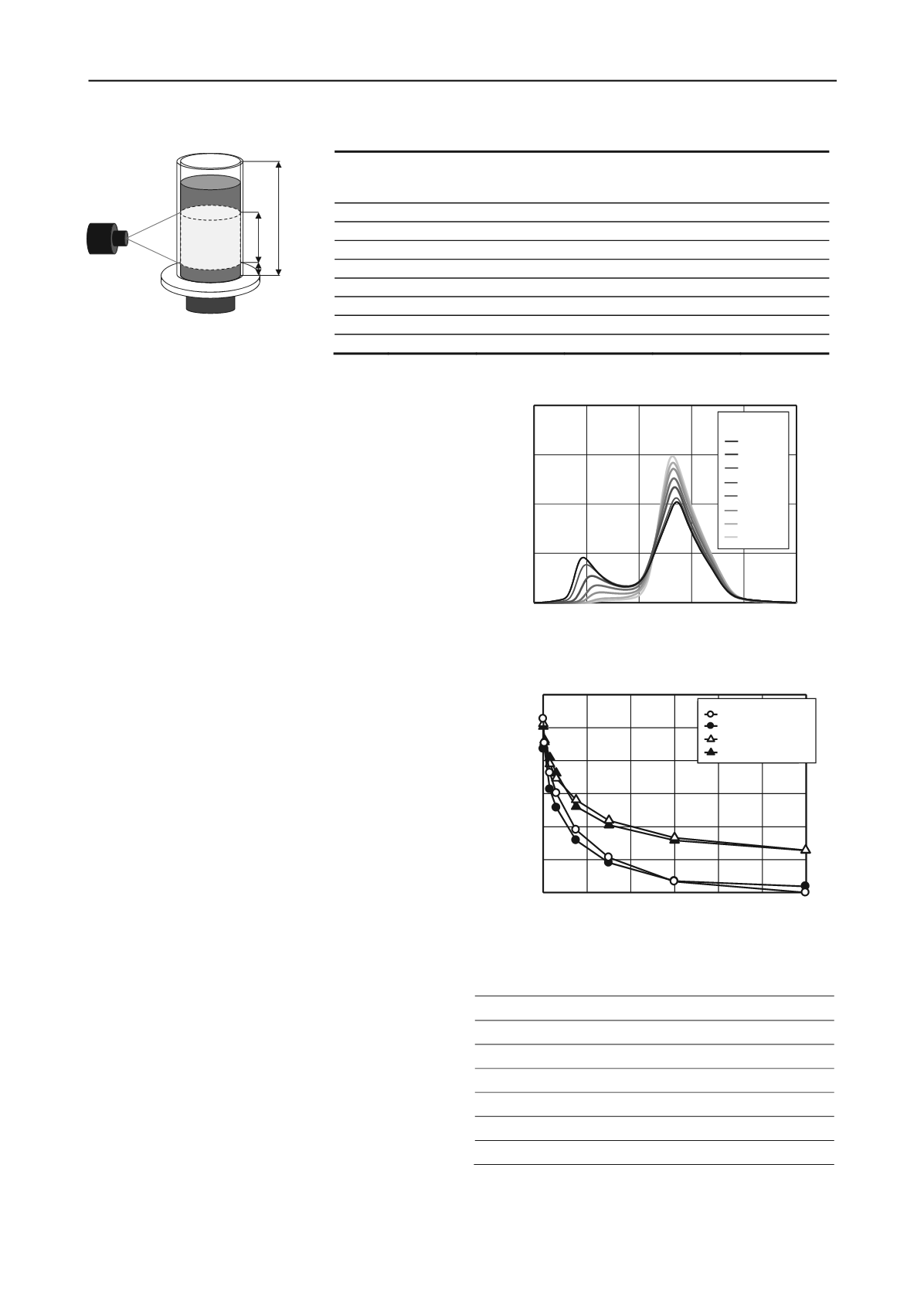
1036
Proceedings of the 18
th
International Conference on Soil Mechanics and Geotechnical Engineering, Paris 2013
Table 2. Test cases and degree of compaction.
For the compaction properties, a series of compaction test were
conducted and maximum dry density of 1.90 t/m
3
and the
optimum water content of 12.3 % were obtained.
First of all, the sand was prepared in the acrylic mould
(height: 100mm, diameter: 50mm) with the conditions of the
optimum water contents and dry density of 1.50 t/m
3
. Dynamic
compaction method was used with controlling its compaction
energy and here, as shown in Table 2, two different cases were
examined, which are Case-1 and Case-2. Case-1 is the case of
relatively high energy in which the height of each time of
falling rammer is 0.20 m while Case-2 is the one for low energy
which is 0.10m for the falling weight. The weight of falling
rammer was 9.81 N. Figure 2 shows those two cases in which
the level of compaction is also shown in this figure. As shown
in this figure, the amount of work was set as equal for both
cases in each level of compaction although the degree of the
compaction was slightly different between two cases. Table 3
shows the conditions of CT scanning and Figure 2 shows the
scanning area of the specimen, which was the area from 15 mm
high and up to 55mm from the bottom of the specimen and the
width of scanning area was 40mm. The precise contents of X-
ray CT can be found in the references (Otani 2003 and
Watanabe et. al. 2012).
3 IMAGE ANALYSIS
The characteristic of compacted soils was discussed with the
results of CT scanning and those are not only direct result from
image visualization but also more quantitative ones such as
distribution of the voids in the soil using image data. In order to
obtain quantitative results, image analysis plays an important
role and especially, the determination of the threshold value
between two materials such as soil particles and voids is most
important for this quantification. Figure 3 shows the frequency
of so called “CT-value” in the whole specimen for Case-1. This
“CT-value” has been known as the well correlated value with
material density (Otani et. al. 2000). As shown in this figure,
there are two dominant CT-values in the specimen and due to
the level of compaction, those peaks are gradually changed. X-
ray CT has a spatial resolution and in this case, this resolution
was 75
m. The sand used in this test has a fine fraction (less
than 5
m) of 8.2% and as a result, there is no way to
distinguish all the sizes of the particles. However, it can be said
from Figure 3 that the higher peak moves to the higher
frequency and the lower peak moves to the lower frequency
after the compaction. This means that the increase of the CT-
value due to compaction is the cause of the fact that the small
particles move to the voids and then those areas are shown as
the areas of higher CT-values. In the mean time, the area of low
density is decreased due to the decrease of the voids. In order to
discuss more quantitative sense, the threshold value of two
peaks shown in Figure 3 was determined. Here, EM algorithm
(Dempster et. al. 1977) which is one of the maximum likelihood
methods was used and this method is useful for the case of
multiple peaks of the frequency curve. Here, the calculation
Compaction
Energy
(kJ/m
3
)
Case-1
No. of
Compaction
Case-1
Deg. of
Compaction
(%)
Case-2
No. of
Compaction
Case-2
Deg. of
Compaction
(%)
Initital
0
0
79.4
0
78.3
LevelA
15
1
83.3
2
81.3
LevelB
75
5
88.2
10
84.7
LevelC
150
10
91.5
20
87.1
LevelD
374
25
97.5
50
90.6
LevelE
749
50
102.0
100
93.8
LevelF
1497
100
106.0
200
96.5
LevelG
2995
200
109.3
400
98.5
Figure 2. Area of CT scanning.
Scan area
(mm)
100
40 15
500 1000 1500 2000 2500 3000
5
10
15
20
25
30
0
Compaction energy (kJ/m 3 )
Porosity (%)
Case-1 measure
Case-1 analysis
Case-2 measure
Case-2 analysis
Voltage (kV)
200-230
Current
A)
350
Spatial resolution (mm)
0.075
Width of slice (mm)
0.050
Number of slices
800
FCD* (mm)
205.0
FDD** (mm)
1000
*: distance from X-ray tube to the specimen
**: distance from the specimen to the detector
Table 3. Condition of CT scanning.
Figure 4. Relationship between porosity and compaction energy.
Figure 3. Frequency of CT-value for Case-1.
0
50
100
150
200
8
250
0
2
4
6
Case-1
initial
Level A
Level B
Level C
Level D
Level E
Level F
Level G
(
×
106)
Frequency
CT-value


